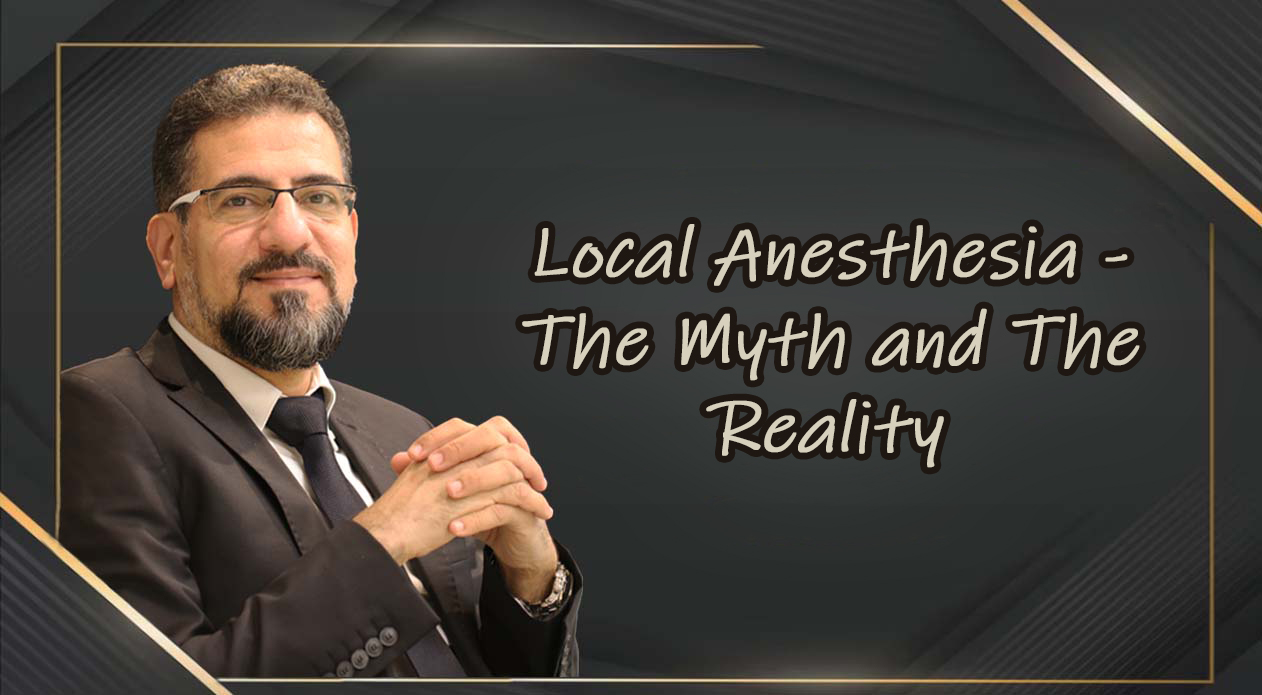Prof. Ayman Hegab is a Professor of Oral & Maxillofacial Surgery, Faculty of Dental Medicine. Al-Azhar University. Cairo. Egypt.
Editorial Note
A myth is a Greek word meaning the telling of stories and its plays a critical role in the field of dentistry. Dental treatment cannot be done during pregnancy, extraction cannot be done in presence of infection, the local anesthesia will not work with the alcoholic patients are common examples of the dental Myth. Unfortunately, these types of Myths are spreading not only between the patients but more worse between the dentists. Local anesthetics (LA) are the most frequently used in dentistry. Anesthesia is used to describe loss of sensation (“an” meaning without + “esthesia” meaning sensation). Here we clarify some of the Myths about LA.
The First Myth
The LA will not work with the alcoholic patients and we need to increase the dose of the LA in such patients.
The Reality
Alcohol-related liver disease (with susceptibility to alcoholic hepatitis and cirrhosis) affects the metabolism of the drugs including Amide LA (Articaine, Bupivacaine, lidocaine, Mepivacaine and Prilocaine, belong to the amide class metabolized by the hepatic microsomal enzyme system, with the exception of Articaine, which is metabolized by serum esterases). So, repeated doses may need to be reduced, or the interval between doses prolonged, to prevent excessive blood levels. Use of an Ester class of LA may not offer any advantage, because pseudo-cholinesterase which is responsible for biotransformation of the Ester LA is also synthesized in the liver. Moreover, complications related to Alcohol-related liver disease (Eg: reduced biotransformation of the LA which predisposes the patient to toxic effects and bleeding due to defect of vitamin K-Depended coagulation factors) are more important than worries about the efficacy of the LA.
The Second Myth
LA cannot be used during pregnancy or nursing patients.
The Reality
To be clear; the pregnancy is physiologic change and not a pathological change, so LA and vasoconstrictors used in dentistry can be safely administered to the pregnant or nursing patient. Fetal bradycardia with Mepivacaine & Bupivacaine was reported during pregnancy, so it should be used with caution and more better to be changed by another type of LA. While, any type of LA associated with Octapressin vasoconstrictor should be avoided during pregnancy. Octapressin (Felypressin) is contraindicated during pregnancy as its similarity in structure to oxytocin (the hormone responsible for labour) can result in some contraction of the uterus. Furthermore; Avoidance of teratogenic drugs, and using the left lateral decubitus position with the right buttock and hip elevated by 15° with avoidance of the supine position are considered as more significant remarks (supine position lead to development of the supine hypotensive syndrome' in which a supine position causes a decrease in cardiac output, resulting in hypotension, syncope, and decreased uteroplacental perfusion. In addition, the supine position may cause a decrease in arterial oxygen tension (PaO2 ) and increase the incidence of dyspepsia from gastroesophageal reflux secondary to an incompetent lower esophageal sphincter. Finally, the supine position poses an increased risk of developing DVT, by compression of the inferior vena cava, leading to venous stasis and clot formation).
The Third Myth
The LA cannot be used with children because it’s dangerous and have damage effect on the permanent teeth.
The Reality
The main concern in pediatrics is the relative ease of inducing an overdose. The dentist should determine the child’s weight and calculate the maximum dose before administering LA to a child. Moreover; selection of a low concentration LA solution appears to be more save. To simply calculate the dose of LA, mg/kg maximum dose of LA agent × kg (of the lean body weight) will divide by the total mg of the LA agent within the cartridge per day. An example: the Mepivacaine 2% LA dose for a 5 years old child can be calculated as the following: the average child weight is 20 Kg (the equation for child age = Age x 2 + 8 = 18) and the maximum Author’s recommended dose of Mepivacaine is 4.4mg/Kg. So the total of LA agent is 88 mg (20 Kg x 4.4). The amount of LA agent in 2% cartridge (1.8 ml) is 36 mg of the local anesthetic agent. Then, a 5 years old child can receive a maximum of 2.4 cartridges per day (88 / 36 = 2.4).
The Fourth Myth
We can use up to 11 carpule of LA with any patient.
The Reality
As we mention before; LA is same as other drugs which should be used within the maximum recommended dose (mg of LA x lean body weight / mg of LA within the cartridge/ day). Furthermore; this dose can be modified and decreased according to the medical condition of the patient (Liver Cirrhosis, Renal Failure).
The Fifth Myth
Most of the patients had drowsiness and fainting in the clinic was a result from fear of the painful injection.
The Reality
The clinical manifestation of overdose of LA include: Cardiovascular signs (Eg: hypertension, hypotension, tachycardia, or bradycardia) may be the first signs of local anesthetic toxicity. CNS excitation (agitation, confusion, twitching, seizure), depression (drowsiness, coma, or apnea), or nonspecific neurologic symptoms (metallic taste, circum-oral paresthesias, diplopia, tinnitus, dizziness) are typical of LA toxicity. So, drowsiness and fainting doesn’t mean vaso-vagal reaction due to pain and fear of injection. It can be easily a early manifestation of the LA overdose. In such case; the dentist should stop administration of LA, place in supine position, monitor all vital signs, administer oxygen and observe in office for at least 1 hr. I prefer if this reaction happened for any patient is to reschedule another appointment if the reaction happened again it will be complicated by the dental treatment which associated with blood, saliva, irrigation, foreign bodies inside the mouth (Eg: crown, bridge, endodontic file). All the previously mentioned will prevent the treating dentist to ensure a potent airway and can threaten the patient life.




 Ask Prof. Hegab
Ask Prof. Hegab +201004401598
+201004401598

